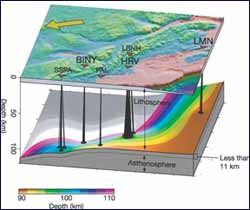Brown Grad Student’s Seismic Study Shakes Up Plate Tectonics

Where even rock is weaker - Between 90 and 110 kilometers below ground, Earth’s hard shell – the lithosphere – meets the more pliable asthenosphere. The boundary between the two layers is no more than 11 kilometers thick, according to a new study.
Earth’s cool, rigid upper layer, known as the lithosphere, rides on top of its warmer, more pliable neighbor, the asthenosphere, as a series of massive plates. Plates continuously shift and break, triggering earthquakes, sparking volcanic eruptions, sculpting mountains and carving trenches under the sea.
But what, exactly, divides the lithosphere and the asthenosphere? In the latest issue of Nature, a trio of geophysicists from Brown University and the Massachusetts Institute of Technology publish research that sheds new light on the nature of the boundary between these rocky regions.
Lead author Catherine Rychert, a 26-year-old graduate student in Brown’s Department of Geological Sciences, found a sharp dividing line between the lithosphere and the asthenosphere, according to data culled from seismic sensors sprinkled across the northeastern United States and southeastern Canada. Rychert and colleagues discovered that sound waves recorded by the sensors slow considerably about 90 to 110 kilometers below ground – a sign that the rock is getting weaker and that the lithosphere is giving way to the asthenosphere. Within in a distance of a mere 11 kilometers – roughly 7 miles or less – the transition is complete.
This evidence runs contrary to the prevailing notion that the lithosphere-asthenosphere transition is a gradual one. It also points up the fact that temperature alone cannot define the boundary. Rychert said that water or a small amount of partly molten rock must also be present in the asthenosphere to cause such an abrupt change in the mechanical strength of the rock.
“These findings will be controversial because they run counter to what some scientists believe is true,” Rychert said. “Regardless, they’re pretty cool. We know something new, literally, about the earth under our feet.”
To conduct the study, Rychert gathered seismic data from hundreds of earthquakes recorded during more than five years at six government-operated or university-run research stations in Canada, New Hampshire, Massachusetts, New York and Pennsylvania. She modeled and analyzed the data with the assistance of Karen Fischer, the Royce Family Professor of Teaching Excellence and professor of geological sciences at Brown, and Stéphane Rondenay, the Kerr-McGee Assistant Professor of Seismology at MIT and a former postdoctoral research fellow at Brown. The project took three years to complete.
“We initially were very surprised by the sharpness of the lithosphere-asthenosphere boundary indicated by the data,” said Fischer, “and so I challenged Kate to prove that such a rapid transition is definitively required. All of her careful modeling has now paid off with a result that makes a fundamental contribution to our understanding of the Earth’s lithosphere.”
The Geophysics Program at the National Science Foundation funded the work.
Media Contact
More Information:
http://www.brown.eduAll latest news from the category: Earth Sciences
Earth Sciences (also referred to as Geosciences), which deals with basic issues surrounding our planet, plays a vital role in the area of energy and raw materials supply.
Earth Sciences comprises subjects such as geology, geography, geological informatics, paleontology, mineralogy, petrography, crystallography, geophysics, geodesy, glaciology, cartography, photogrammetry, meteorology and seismology, early-warning systems, earthquake research and polar research.
Newest articles

Sea slugs inspire highly stretchable biomedical sensor
USC Viterbi School of Engineering researcher Hangbo Zhao presents findings on highly stretchable and customizable microneedles for application in fields including neuroscience, tissue engineering, and wearable bioelectronics. The revolution in…

Twisting and binding matter waves with photons in a cavity
Precisely measuring the energy states of individual atoms has been a historical challenge for physicists due to atomic recoil. When an atom interacts with a photon, the atom “recoils” in…

Nanotubes, nanoparticles, and antibodies detect tiny amounts of fentanyl
New sensor is six orders of magnitude more sensitive than the next best thing. A research team at Pitt led by Alexander Star, a chemistry professor in the Kenneth P. Dietrich…





















